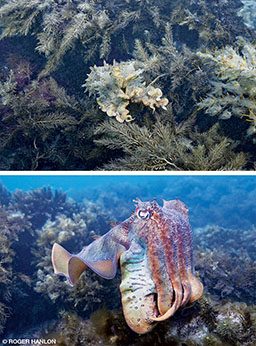No creature on the planet can change its camouflage as fast and effectively as an octopus, cuttlefish or squid. These speed merchants of adaptive coloration can change their skin’s color, brightness, contrast and pattern in as little as 200 milliseconds — one-fifth of one second — as fast as a human eyeblink.
This is no small feat given the complexity of backgrounds in marine environments (such as those found on coral reefs). What’s more, an octopus must carefully orchestrate 10 million to 20 million chromatophore organs in its skin as well as another million or so iridescent cells and perhaps several thousand skin bumps (called papillae) to tailor its camouflage pattern to every specific microhabitat it stops in while foraging. Of course, if you can change your appearance, you have to control it, and that requires good vision and a large brain to process the visual information, send signals to all those skin elements and get the pattern deployed.
Why and How
A colleague once quipped, “Cephalopods occupy the behavioral space of fishes,” and that is an appropriate viewpoint from which to begin the discussion. After all, the bony fishes (snappers, groupers, barracudas, tunas, etc.) dominate most marine ecosystems, and they have some of the most sophisticated visual systems known. And they all eat cephalopods, which are essentially tasty and nutritious hunks of protein. Cephalopods have been found in the stomachs of a vast array of marine mammals, diving birds and fishes — they exist in the middle of the food chain. Therefore the soft-bodied cephalopods have to “live by their wits” and be fast, clever and hard to find. The keen visual systems of their predators are foremost among the selective forces that led to the evolution of cephalopods’ diverse and detailed camouflage
How cephalopods managed this evolution is more difficult to uncover. A basic flaw in biological thought during the past century is the idea that camouflage is “looking like the background.” In retrospect, this does not make much sense simply because there are too many backgrounds. A typical Caribbean coral reef, for example, has 600 to 1,000 species on it (e.g., corals, bryozoans, tunicates, algae, seagrasses, etc.), so trying to resemble that many backgrounds is a senseless idea. A better approach is to study the animal group that changes its camouflage dynamically throughout these complex backgrounds (cephalopods) and determine how many patterns it needs and what sorts of tricks it has evolved to deceive multiple visual predators. One sage put it thus: “Camouflage is the least-studied biological subject that we think we already know about.” Fortunately, that is changing.
Some Basic Tricks
A very surprising finding came from studies of cuttlefish camouflage. When researchers assembled thousands of images of camouflaged cuttlefish from dives and laboratory experiments, they found only a few basic camouflage pattern designs. This counterintuitive phenomenon has since been verified to a large extent. It suggests that marine predator vision can be deceived by a small number of pattern designs. These pattern types are known as uniform, mottle and disruptive, and they work via different tactics. The first two retard detection by the predator, while disruptive patterns work by making it difficult to recognize the prey even though it might be easy to detect. (The images in this article show some of these patterns.) Following implementation of these pattern designs, some cephalopods use masquerade to look like an inanimate object or mimicry to look like another animal.
The elegance of the three-pattern system is that it helps explain how the cephalopods can change so fast. The most parsimonious explanation is that they need to see only one visual cue in the background to turn on a disruptive pattern and another to turn on mottle; uniform could be a default pattern. If the cephalopod instead analyzed all the visual information from surrounding corals, it would need a super computer to analyze that amount of information — and that would take time as well. Since the animals make these magical transformations in less than a second, the single-cue explanation is probably on the right track.
Optical Illusions and 3-D Skin
Cephalopod camouflage patterns are an art form. Designed to deceive a wide array of visual systems, they incorporate numerous optical illusions. The edges and outlines of the octopus and cuttlefish are elegant patterns that often make the edge of the animal blend into the background. In disruptive patterns, various false edges are produced in different shapes and orientations throughout the inboard aspects of the body so that a viewing predator sees many edges and parts, but these do not amount to a recognizable prey item. That is, the cuttlefish, squid or octopus no longer has a recognizable body shape, outline or pattern.
In addition, only cephalopods have evolved the unique ability to morph their skin into various grades of bumpiness with well-controlled skin papillae, which can range from flat and invisible (i.e., smooth) to spiky in many degrees to match the 3-D rugosity of the substrate. This helps to obscure the outline of the animal too, since if its skin were smooth its outline would stand out against nonsmooth backgrounds such as coral polyps or hydrozoan-populated seagrass fronds.
How to Find a Camouflaged Ceph
Cephalopods are hard to spot. Octopuses are especially so because with their malleable bodies they can twist and turn their arms and mantle into all sorts of shapes that render their telltale arms indistinguishable. It is nearly impossible to find an octopus that is camouflaged while it is foraging. We biologists have been swimming over them for decades.
It is better to find the animal’s den and watch it for long periods until the animal emerges to forage. The octopus can then be habituated to diver presence so that it will forage, and the diver can follow it at a discrete distance to watch the amazing sequences of camouflage on different backgrounds. This approach requires immense patience though. Volunteer divers have greatly facilitated such studies and contributed to substantial biological discoveries.
Color-Blind Camouflage

One of the most perplexing issues is that cephalopods are color-blind yet seem to have color-coordinated patterns for a wide range of colorful backgrounds. Some of the pigments in their skin chromatophores (yellow, red and brown) are common colors underwater for plants and animals, so some passive color coordination could emanate from that. But the precision with which the overall camouflage pattern seems color-coordinated demands a better explanation, yet science has not yet figured one out.
An amazing and serendipitous discovery did emanate from this conundrum: it turns out the skin has the same light-detecting molecules as those found in cephalopods’ retinas. So, hypothetically, the skin can somehow sense light and perhaps even color. Currently this idea is a bit of a pipe dream, but this is the way scientific inquiry proceeds — an unusual discovery transforms the way a problem is probed.
Hyperspectral Imagers Are the Future
While the photographs in this article may look color-coordinated, consider that they were captured using cameras made exclusively with human vision in mind. Animals’ vision is tuned to other colors, and thus the color world looks different to them than to us. So how do we begin to view camouflage through the eye of the beholder? That is, how do we know what these animals look like to the predators that search for them under a variety of natural lighting conditions, which change throughout the day and with depth?
New cameras called hyperspectral imagers (HSI) are being developed to acquire color-rich images so that it is possible in postprocessing to tune the resulting photograph to the color gamut of different predators with different color-viewing capabilities. This will elevate the ecological study of visual predator-prey interactions and help quantify the color aspects of camouflage in realistic scenarios. Don’t be surprised if scientists demonstrate that an octopus camouflaged to you is not as well color-camouflaged to a barracuda. Such studies are difficult, yet advancing technology can open the door to new approaches such as this.
The diving world is a goldmine of color and pattern diversity. Charismatic species such as cephalopods, which are the masters of color change on planet Earth, are fun to watch though sometimes challenging to find and study. Their camouflage is highly sophisticated, and those who witness it are usually in awe. So sharpen your eyes, and good hunting.
NOTE: These photos of camouflaged animals were taken using available light; the use of strobe lighting could potentially alter their behavior and our perception of their color.
| © Alert Diver — Q4 2017 |


